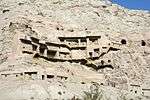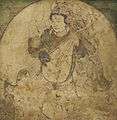Kizil Caves
| 克孜尔千佛洞 | |
 Kizil Caves on the edge of the Tarim Basin. | |
 Shown within Xinjiang | |
| Location | Xinjiang, China |
|---|---|
| Coordinates | 41°47′N 82°30′E / 41.783°N 82.500°ECoordinates: 41°47′N 82°30′E / 41.783°N 82.500°E |
| Kizil Caves | |||||||||
| Chinese name | |||||||||
|---|---|---|---|---|---|---|---|---|---|
| Simplified Chinese | 克孜尔千佛洞 | ||||||||
| Traditional Chinese | 克孜爾千佛洞 | ||||||||
| Literal meaning | Kizil Cave of a Thousand Buddhas | ||||||||
| |||||||||
| Uyghur name | |||||||||
| Uyghur |
قىزىل مىڭ ئۆي | ||||||||
| |||||||||
The Kizil Caves (also romanized Qizil Caves, spelling variant Qyzyl) are a set of Buddhist rock-cut caves located near Kizil Township (克孜尔乡, Kèzī'ěr Xiāng) in Baicheng County, Xinjiang, China. The site is located on the northern bank of the Muzat River 65 kilometres (75 km by road) west of Kucha.[1][2] This area was a commercial hub of the Silk Road.[3] The caves are said to be the earliest major Buddhist cave complex in China,[3] with development occurring between the 3rd and 8th centuries.
Caves
The Kizil Caves complex is the largest of the ancient Buddhist cave sites that are associated with the ancient Tocharian kingdom of Kucha, as well as the largest in Xinjiang. Other cave sites in the Kucha region include the Kumtura Caves and Simsim Caves.
There are 236 cave temples in Kizil, carved into the cliff stretching from east to west for a length of 2 km.[1] Of these, 135 are still relatively intact.[4] The earliest caves are dated, based in part on radioactive carbon dating, to around the year 300.[5] Most researchers believe that the caves were probably abandoned sometime around the beginning of the 8th century, after Tang influence reached the area.[6] Documents written in Tocharian languages were found in Kizil, and a few of the caves contain Tocharian inscriptions which give the names of a few rulers.
Many of the caves have a central pillar design whereby pilgrims may circumambulate around a central column which is a representation of the stupa. A large vaulted chamber is located in front of the column and a smaller rear chamber behind with two tunnel-like corridors on the sides linking these spaces. In the front chamber, a three-dimensional image of Buddha would have been housed in a large niche serving as the focus of the interior, however, none of these sculptures have survived at Kizil.[7] The rear chamber may feature the parinirvana scene in the form of a mural or large sculpture, and in some cases, a combination of both.
There are three other types of caves: square caves, caves with large image, and monastic cells (viharas). Around two-thirds of the caves are viharas which are monks' living quarters and store-houses, and these caves do not contain mural paintings.
Murals
In 1906, the German expedition team of Albert von Le Coq and Albert Grünwedel explored the Kizil Caves. While Grünwedel was primarily interested in copying the murals, von le Coq chose to remove many of the murals. Most of the fragments removed are now in Museum of Asian Art (formerly Museum für Indische Kunst) in Dahlem, Berlin.[8] Other explorers removed some fragments of murals and may now be found in museums in Russia, Japan, Korea and United States. Although the site has been both damaged and looted, around 5000 square metres of wall paintings remained,[9] These murals mostly depict Jataka stories, avadanas, and legends of the Buddha, and are an artistic representation in the tradition of the Hinayana school of the Sarvastivadas.[1]
According to a text found in Kucha, the paintings in some of the caves were commissioned by a Tokharian (Thogar) king called "Mendre" with the advice of Anandavarman, a high-ranking monk. The king ordered an Indian artist, Naravahanadatta, and a Syrian artist, Priyaratna, with their disciples to paint the caves.[1] The neighbouring Khotanese kings Vijayavardhana and Murlimin also assisted with the painting of another cave by sending artists to the site.
A notable feature of the murals in Kizil is the extensive use of blue pigments, including the precious ultramarine pigment derived from lapis lazuli from Afghanistan. In the classification of the art of the region by Ernst Waldschmidt, there are three distinct periods:[1] the murals from the first phase are characterized by the use of reddish pigments, while those from the second phase used bluish pigments in abundance.[6] The earlier paintings reflect more Greco-Indian or Gandharan influences, while the second ones show Iranian (Sassanian) influences.[5] Later caves seem to have fewer legends and/or jatakas, being replaced by the repetitive designs of numerous small Buddhas (the so-called thousand Buddha motif), or sitting Buddhas with nimbuses.[1] The paintings of the first two phases showed a lack of Chinese elements.[6] The last phase is the Turkic-Chinese period which is centered around Turfan but in Kizil only two caves showed Tang Chinese influence.
Another characteristic of the Kizil murals is the division into diamond-shaped blocks in the vault ceilings of the main room of many caves. Buddhist scenes are depicted inside these diamond-shapes in many layers on top of one another to show the narrative sequences of the scenes.[1]
Gallery
 View of caves
View of caves Tocharian Donor figures
Tocharian Donor figures Tocharian Donor figures, cave 8
Tocharian Donor figures, cave 8 Mural in diamond-shaped blocks characteristic of Kizil Caves.
Mural in diamond-shaped blocks characteristic of Kizil Caves.- Fragments of painting
- Head of Mahakasyapa

 Dance of princess Chandraprabha, cave 83
Dance of princess Chandraprabha, cave 83 Goddess and celestial musician
Goddess and celestial musician
See also
- Bezeklik Thousand Buddha Caves
- Kumtura Thousand Buddha Caves
- Mogao Caves
- Tianlongshan Grottoes
- Ajanta Caves
- Major National Historical and Cultural Sites (Xinjiang)
- Serindian art
Footnotes
- 1 2 3 4 5 6 7 Manko Namba Walter (October 1998). "Tokharian Buddhism in Kucha: Buddhism of Indo-European Centum Speakers in Chinese Turkestan before the 10th Century C.E" (PDF). Sino-Platonic Papers (85).
- ↑ "Kezil Thousand-Buddha Grottoes". xinjiang.gov. Archived from the original on 2007-09-30. Retrieved 2007-08-05.
- 1 2 "Kizil Thousand-Buddha Cave". Retrieved 2007-08-05.
- ↑ "Caves as Canvas: Hidden Images of Worship Along the Ancient Silk Road". Sackler Gallery. Smithsonian Institution.
- 1 2 Daniel C. Waugh. "Kucha and the Kizil Caves". Silk Road Seattle. University of Washington.
- 1 2 3 Makiko Onishi, Asanobu Kitamoto. "The Transmission of Buddhist Culture: The Kizil Grottoes and the Great Translator Kumārajīva".
- ↑ "Caves as Canvas: Hidden Images of Worship Along the Ancient Silk Road - Architecture, Decoration, and Function". Sackler Gallery. Smithsonian Institution.
- ↑ "Caves as Canvas: Hidden Images of Worship Along the Ancient Silk Road - The Rediscovery of Qizil". Smithsonian Institution.
- ↑ Kizil Thousand-Buddha Caves: Valuable Record of Buddhism Culture in Xinjiang
External links
| Wikimedia Commons has media related to Kizil Caves. |
- Along the ancient silk routes: Central Asian art from the West Berlin State Museums, an exhibition catalog from The Metropolitan Museum of Art (fully available online as PDF), which contains material from Kizil Caves
- The Oases of the Northern Tarim Basin
- Revealing the Beauty of the Kizil Caves
- "Sackler Gallery exhibition in 2002- Caves as Canvas: Hidden Images of Worship Along the Ancient Silk Road". Smithsonian Institution.